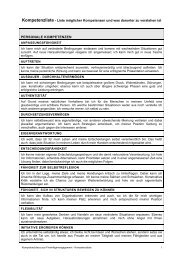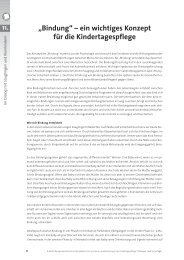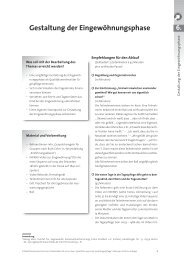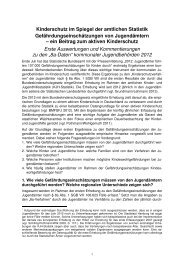download - Deutsches Jugendinstitut e.V.
download - Deutsches Jugendinstitut e.V.
download - Deutsches Jugendinstitut e.V.
You also want an ePaper? Increase the reach of your titles
YUMPU automatically turns print PDFs into web optimized ePapers that Google loves.
Dr. Susann Burchardt, Dr. Heike Förster, Tatjana Mögling<br />
German Youth Institute e.V. Halle/Saale<br />
Introduction<br />
This documented European experts’ conference “Children and Young Persons in<br />
Disadvantaged Neighbourhoods – New Cohesion Strategies” was organised by the<br />
German Ministry for Family Affairs, Senior Citizens, Women and Youth within the<br />
framework of the German EU Presidency of the European Council and took place from<br />
26 to 28 June 2007 with ca. 400 participants in the Congress Centre Leipzig.<br />
This conference was a continuation of the European discussion process concerning<br />
action plans and integration strategies for young persons in disadvantaged neighbourhoods,<br />
urban areas and rural regions which had begun in Berlin in 2004 and was resumed in<br />
Strasbourg in 2006.<br />
In Berlin and Strasbourg, it became clear that the existing problems in European<br />
countries displayed a wide range of differences in certain parts. This is underlined by the<br />
results of the scientific accompaniment to the programme “Development and<br />
opportunities for young persons in disadvantaged neighbourhoods (E&C) ” and other<br />
studies: disadvantaged urban areas and regions in Europe display a wide range of<br />
substantial socio-environmental and socio-structural differences which display a high<br />
degree of inhomogeneity. Correspondingly, the individual approaches in the handling of<br />
these problems in disadvantaged neighbourhoods are also highly variable.<br />
A systematic comparison of fundamental national political strategies has not yet been<br />
undertaken on a European level.<br />
The local actors in European countries repeatedly establish that accessible data for the<br />
description of problem complexes in their neighbouring areas display substantial<br />
differences. This has meant that local authorities with little knowledge of general<br />
conditions and problem complexes have encountered great difficulties in the planning of<br />
concrete development targets for their disadvantaged neighbourhoods. This produces<br />
uncertainty as to which specific approaches are necessary for the improvement of living<br />
conditions and opportunities for young persons in these areas.<br />
Against this background, the aim of the European experts’ conference in Leipzig was<br />
the comparison of national strategies and programmes from a variety of European<br />
countries and also relevant national frameworks, institutional facilities and local<br />
implementation. Similarities and differences should be established and a joint European<br />
learning process initiated. Through this process, recommendations for the development of<br />
strategies for the integration of young persons in disadvantaged neighbourhoods should be<br />
developed for EU member states and the European political bodies.<br />
The European experts’ conference in Leipzig examined the differing social and political<br />
general framework of the various national strategies and programmes for children in<br />
disadvantaged neighbourhoods.<br />
The welfare state concept of a country provides general criteria for political, economic<br />
and social decisions, e.g. who should receive which social services and welfare benefits and<br />
under which conditions these services are performed and by whom. Differences in welfare<br />
3

















